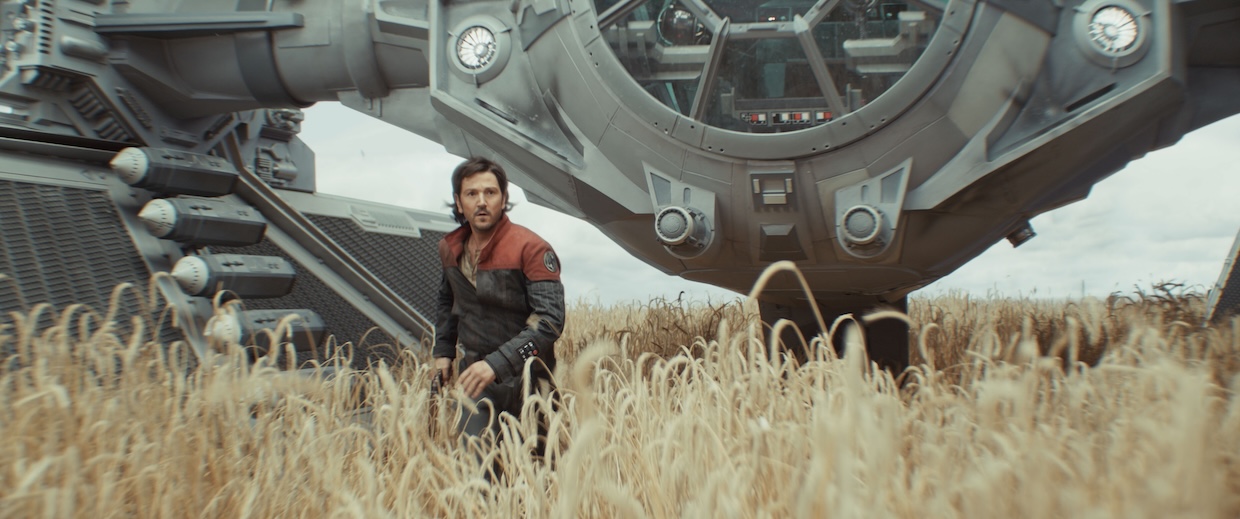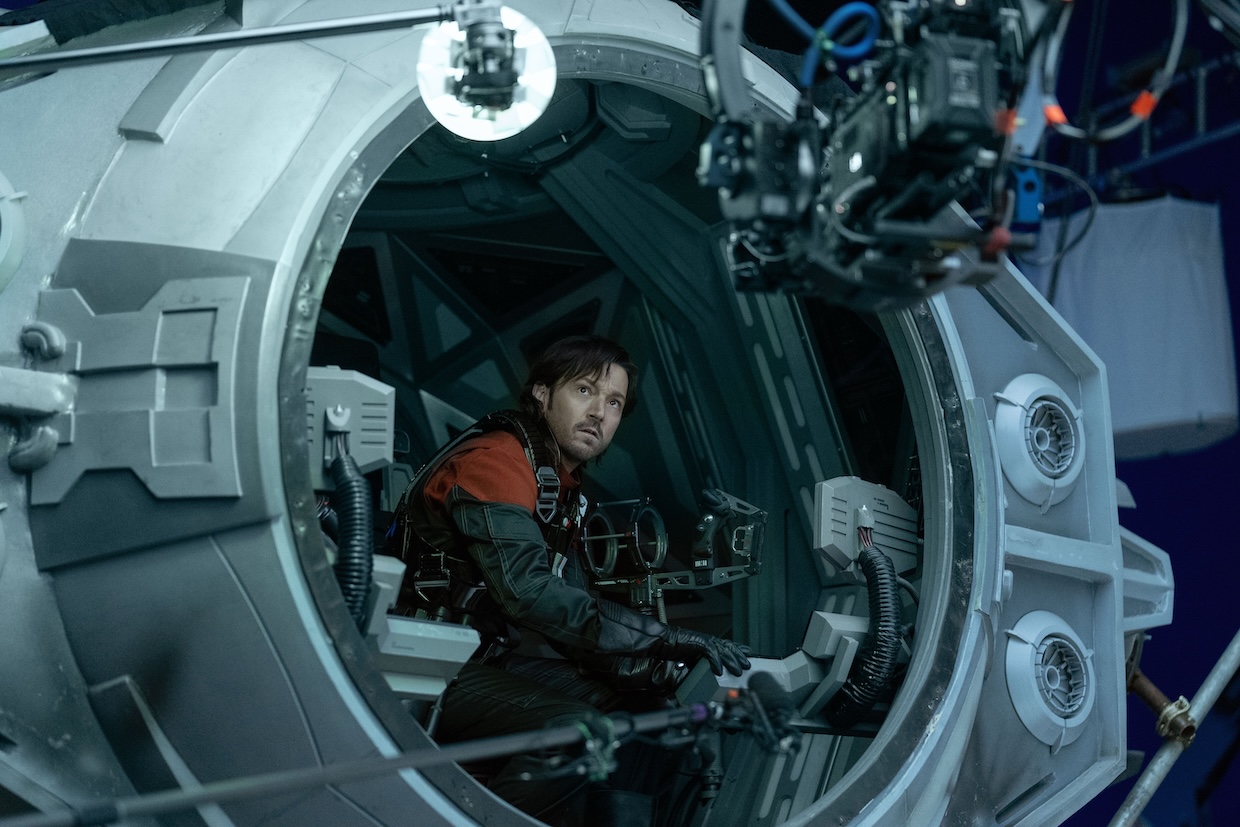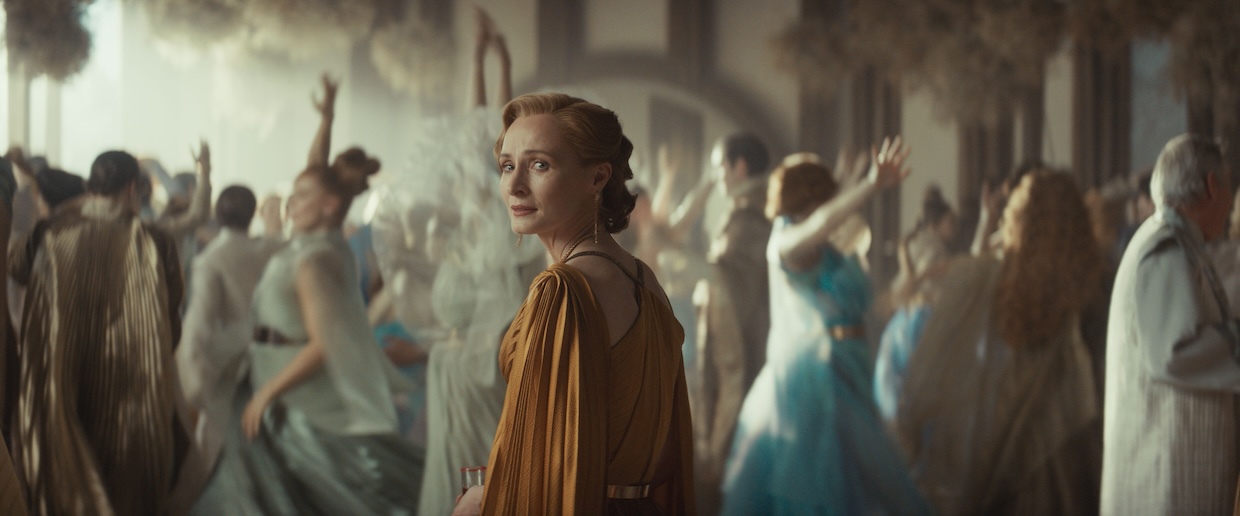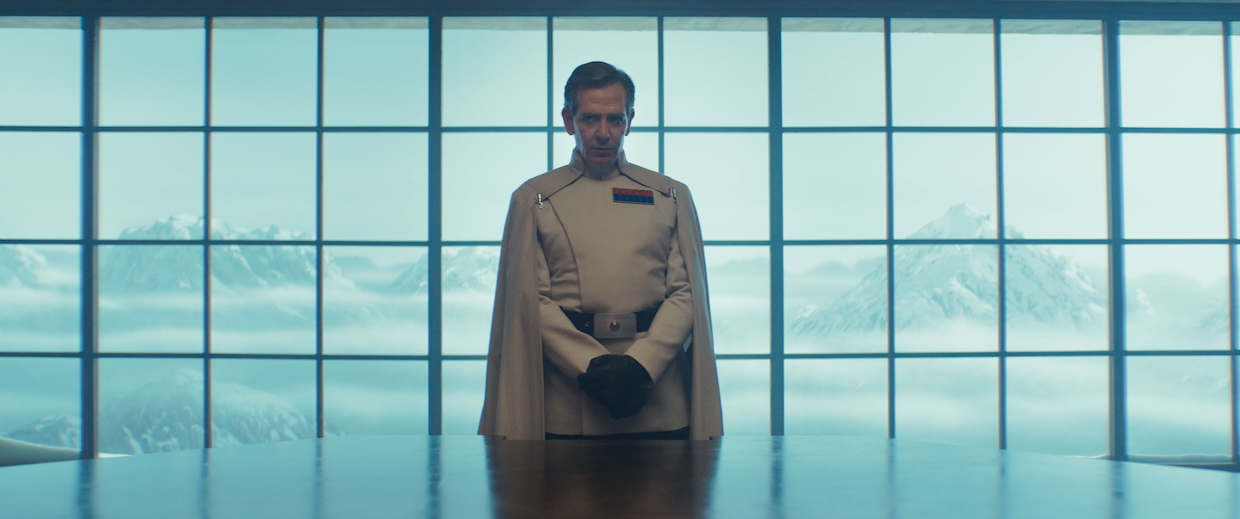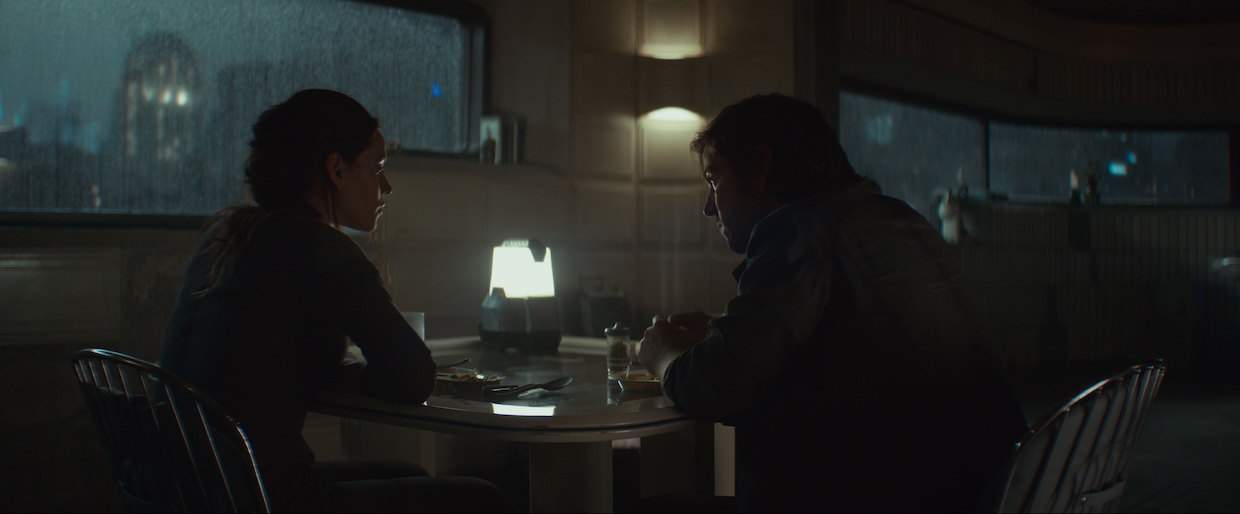 Back to selection
Back to selection
Shutter Angles
Conversations with DPs, directors and below-the-line crew by Matt Mulcahey
Space in 40mm: DP Christophe Nuyens on Andor Season Two
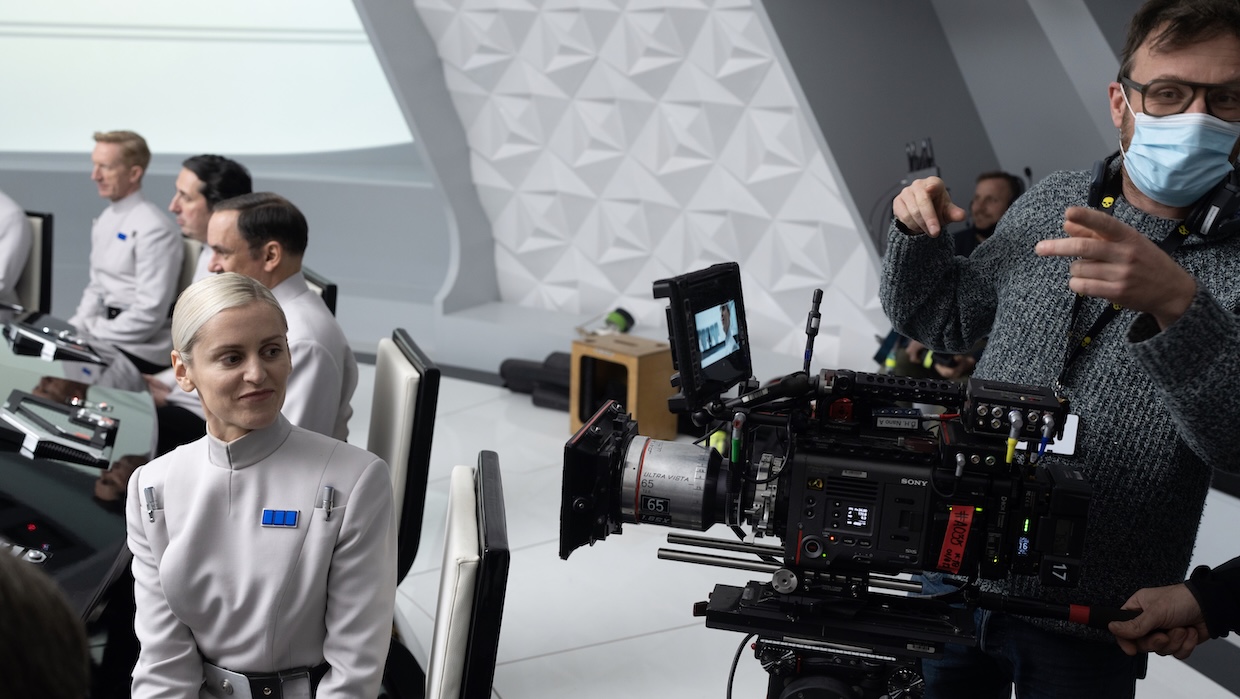 DP Christophe Nuyens (right) on the set of Andor season two
DP Christophe Nuyens (right) on the set of Andor season two When it comes to streaming series, it’s better to have too little of a great show than too much. With a finite amount of time to work with before the events of Andor collide with their preordained conclusion in Rogue One, the Disney Plus prequel series opted not to spin its wheels for a superfluous three or four extra seasons like so many shows that lurch onward past what should be their expiration date.
The second and final season of Andor picks up a year after season one, with each three-episode block then jumping another year into the future as Cassian Andor (played by Diego Luna) and his cohorts build the rebel resistance to the Empire’s oppressive rule.
With all episodes now available for streaming, cinematographer Christophe Nuyens spoke to Filmmaker about lensing the final season of the acclaimed series.
Filmmaker: Walk me through the timeline of making the new season and how the strikes affected production. You shot the first six installments of the twelve-episode season. Were you almost done with your portion when production paused?
Nuyens: The first thing shot [on the new season] was the second block, which was episodes four, five and six. That was totally unaffected by the strike. However, the first three episodes were actually the last ones shot and were really affected by the strike. Production planted grain fields [for scenes set on Mina-Rau] and there was a really small window of about four weeks where the crop was at a good height and a good color. We planned it very meticulously to be there at the right moment and, the day before we had to leave [to start shooting that location], the strike started.
Filmmaker: So, even though the opening block of three episodes occurs first chronologically in the story, you shot those last because that’s when this crop of rye that production planted would be usable.
Nuyens: That’s right.
Filmmaker: Did you get to shoot anything in that practical location, or did it all have to be moved on stage?
Nuyens: Because everything was in place and all the sets were built, we decided to continue shooting with half of the actors. That meant we could only shoot specific scenes [at the practical location], then six months later we created everything again at Pinewood Studios on stage with artificial lights and all the crop on foam boards. That was quite a challenge.
Filmmaker: Most people probably won’t notice what’s practical and what’s on stage, but I’m sure it drives you crazy.
Nuyens: It’s difficult to let go, but I think that’s just the DP in me. Now that I have a bit of distance I’m happy about [how those scenes turned out].
Filmmaker: Was it not possible to rebuild the field on a backlot rather than on a soundstage just for the natural sunlight?
Nuyens: We had those discussions, but a backlot in the UK in winter would’ve been tough. We had already shot some of episodes four, five and six on the backlot [the previous] winter and it was freezing and raining. We didn’t want to do that [for those rye fields, so we decided, “OK, let’s do it on a stage.” The good thing about the stage is that you can control everything light-wise. When we were shooting in the [practical] fields, we were already prepping for the stage work in our minds. We were measuring all the details of the lighting. For every scene, we measured the ambient color temperature, the sun color temperature, to recreate exactly the same conditions on the stage. We even added wind machines and particles flying through the air on stage just to make it feel more real.
Filmmaker: Cinematographers have told me how difficult it can be to recreate sunlight on stage. It’s hard to get a big enough source far enough away to really replicate it. What was your solution?
Nuyens: Actually, when we were shooting in the real fields we were quite lucky. Most of the time there were tiny little clouds in front of the sun. It was perfect light. You have direction, but it’s soft. So, when we were in the stage, I prepped a big Manitou with hard LED sources, which I could soften up a little bit to try to match the practical location lighting.
Filmmaker: Mood boards were created for the different locations on the series. For those fields, was it all just shots from Days of Heaven?
Nuyens: Actually, for that location I used a little bit of The Assassination of Jesse James by the Coward Robert Ford in the mood boards. I also had a show I shot in Kazakhstan in the desert, which was shot in fields [that stretched] as far as you could see. So, I had already shot something similar and used that also as a reference.
Filmmaker: I know you used the Panavision Ultra-Vistas, but a couple sources have also listed the Panavision C Series anamorphics. Those were used on season one, but did you have them again for the new season?
Nuyens: No. I like the C Series, but they don’t cover the full sensor of the Venice and I wanted to use the full sensor. With the Panavision Ultra-Vistas and their crop factor of 1.6x [coupled with the Venice’s 1.5:1 sensor size, you use the whole sensor [to get a 2.40 final aspect ratio]. You don’t have to throw anything away. For me, that meant that we were getting closer to the [feel of the] Alexa 65 used on Rogue One.
Filmmaker: You talked in an interview about how, unlike many newer lens sets, the Ultra-Vistas aren’t uniform.
Nuyens: Yes. We had two 40mm lenses where the stop was different, the close focus was different and even the look was slightly different—in a good way, I think, because that gave us different tools for different shots. In the beginning I was struggling a little bit with it, but then as [director] Ariel [Kleiman] and I got to know the lenses we could use them almost as different paint brushes. We had nicknames for the lenses. Instead of saying, “Let’s go with the 40mm,” we would say, “I want The Big 40.”
Filmmaker: Cinematographers will sometimes write down the serial numbers of specific lenses they like. Did you keep track of those in case you want to use the Ultra-Vistas again in the future?
Nuyens: Oh yeah, I have a list of them with all the serial numbers. My camera assistants were keeping that list during the shoot, and I was giving them notes on the lenses, and now I have an Excel file with all that info.
Filmmaker: Let’s get into some specific scenes, starting at the beginning with Cassian boosting a TIE Fighter from an Empire training facility to open the first episode. Walk me through lighting that huge space. You can see the set-up in one of the making-of videos that Disney put together. [It’s around the 1:50 mark here.] The set is full of space lights, with bluescreen in the opening where the TIE fighter flies out.
Nuyens: We tried to shoot as much as possible in camera and everything else was extended. All the Arri SkyPanels in the ceiling with space light skirts on them were individually controllable to shape the lights or to play the red lights flashing [when Cassian trips a security alarm].
Filmmaker: What’s the difference in look that you get between making a giant soft box with a bunch of SkyPanels and one big diffusion compared to all these individual space lights? Is there a reason to do one versus the other?
Nuyens: I prefer to use the SkyPanels because you can control them color-wise and dim them [remotely]. If you use real space lights, you’re a little bit tied to the tungsten. One big soft box is nice, but it doesn’t allow you to control [the light as much]. If we wanted to play those red lights flashing [with a big soft box], it would become too soft and milky. For some sets we did use a big silk diffusion, and for other sets we just used space light skirts like we did here.
Filmmaker: For the shots of Cassian in the TIE fighter cockpit, you’re on a gimbal running six Sony cameras—two Venices, two FX3s and two FX6s.
Nuyens: In that scene we had previs and there were so many different shots in there. If you had to dissect all those shots in little beats, it became a bit unnatural to play for Diego. So, we decided, “Let’s just mount all those angles we need, then Diego can play the whole sequence [all the way through].” The FX3s and 6s were for little beats, like when he was looking behind him, but the main two cameras were in front of him. Those were the Venices; one was fixed and the other was on a stabilized head, so if the gimbal moved left or right you really had the feeling that Diego was taking corners. We could zoom also a little bit and it make it a bit more dynamic.
Filmmaker: Another storyline for the opening block of episodes is the wedding of Mon Mothma’s daughter in the mountains of Chandrila. One of the first shots there is a long Steadicam that tracks with Mon Mothma [played by Genevieve O’Reilly] as she greets wedding guests. I’m assuming this had to be shot on the backlot because the set covers such a huge area.
Nuyens: It was a big set, like a lot of our sets were. We shot that on a 40mm and tried to make her journey toward the end position as interesting as possible. We talked with production designer Luke Hull about having portions of the set covered [by things like overhead walkways and thatched roofs] so there were variations in light. We also had some Manitous with big blacks to shape the light a bit, as well as Manitous with greenscreen to extend the background. The first time we tried shooting that scene it started raining, so we went inside to our cover set. We came back a few days later to try again and it was almost raining, which was actually quite lucky because if you have [hard direct] sun it can become really difficult with the Steadicam shadows, especially on a wide lens like a 40mm.
Filmmaker: In that first block of episodes, we’re following several different stories—Cassian and his stolen TIE Fighter, the Chandrilan wedding, Bix hiding out on Mina-Rau and the Empire plotlines with Dedra and Syril. How much did you want to differentiate each of those different stories?
Nuyens: Every planet has its own look. For example, most of the time I use LEDs, but for the wedding everything except for the space lights was tungsten, which is quite rare for me. It was important for us to have the feeling of natural light and the sun coming in. We also decided that the wedding had to have a time lapse. The wedding started around noon and kept on going until dusk. In every scene we played that the sun was going lower and lower until the end of episode three, where it’s flaring and quite contrasty.
Filmmaker: Let’s go back to oners and talk about the one on Ghorman, where the local resistance fighters hijack weapons from an Empire transport. There’s a shot that starts high up, pushes into the transport vehicle as a case of weapons is unloaded and then is shoved down a tunnel with the camera following. How did you pull that shot off?
Nuyens: We had two sets. We had the street set with the transport vehicle and first bit of tunnel. I think we had two meters of tunnel. Then we had a second set with maybe six or seven meters of tunnel and the [underground section] where [the stolen weapons are being loaded onto a new truck]. The first bit on the street is on a Technocrane 45, which was too short, so we had it on track as we pushed over the truck and into the tunnel. Then there’s a hidden cut in the tunnel and VFX takes over until the last seven meters of the tunnel. Then we take over again [on the underground set] with the Technocrane, which was on scaffolding to give us the angle we needed. At the bottom we took off the camera from the crane, which was on a Stabileye, and carried it into the [rebel] truck.
Filmmaker: Going back to the crop fields on Mina-Rau, there’s behind the scenes footage [check out the 1:07 mark in this video] of the rig you used to shoot Brasso on his speeder zipping through the fields. You’ve basically got the speeder with the actor on it attached directly to the picture vehicle so they can move in unison.
Nuyens: We were driving quite fast with that thing. It was important that it felt real, because sometimes those speeder scenes feel a bit fake if they’re just done in front of a greenscreen. We had a stabilized camera to film him, then did the trip again but without Brasso on the speeder just to film the foreground. Then VFX added the foreground into the shot. There are other shots [in that sequence] from behind him that were almost done entirely in camera. It’s a speeder on a motorbike driven by a stunty and we are driving behind him with another motorbike with a stabilized camera through the fields, which was quite spectacular. VFX didn’t do a lot on that shot, just maybe adding some dust. That’s the approach we took for this season was to try to do as much as possible in camera. For example, there’s a scene in a conference room—
Filmmaker: I was going to ask about this. You used paintings for the mountainscape outside the window. There were other times when you used bluescreen/greenscreen or a portable Stagecraft set-up for those window views. What factors dictated which approach you used for which scenes?
Nuyens: For every scene that had to be bright, a painted backdrop worked best. In the conference room and also in the wedding scene we used a painted backdrop because you can really throw a lot of light on that backdrop so it illuminates the set. That’s impossible with greenscreen or bluescreen, and LED walls are most of the time not powerful enough to make it glow like that.
Filmmaker: Why a painted backdrop as opposed to something printed like a translight? Is it made of a different material that you can frontlight and basically use as a bounce source?
Nuyens: Yeah. I think we had eight SkyPanel 360s just lighting the backdrop. We had another four 360s with diffusion throwing light inside [the set], but most of the light actually comes from the backdrop. It’s important for me on shows like this that the outside is slightly overexposed, because that makes it feel more real. If you’re working with VFX, you can make it too perfect and it was important for me that everything felt like you were shooting on location.
Filmmaker: The spaces related to the Empire have a different palette than the rest of the series. It’s largely white and gray with little other color.
Nuyens: We wanted everything around the Imperial Security Bureau to be quite neutral and most of the time also quite bright. Lighting-wise, those scenes were quite easy, maybe because it’s all neutral, but camera-wise we also tried to make those scenes as graphic as possible to distinguish them from other scenes.
Filmmaker: There’s behind-the-scenes footage of Syril in his Ghorman office where you’ve got a China ball on the floor with him. When you’re lighting these huge spaces, what are you using on the ground to supplement?
Nuyens: Most of the time, if it’s possible, I’m trying to bounce just with a poly or something like that. I also love to use the Orbiters with the spot on them to bounce into a ceiling or on the floor. For me that makes it feel the most natural, but sometimes it was just not possible that way and we would use a China ball with an LED in it or one of those little DMG Dash lights. We even used those in frame sometimes because they have a Star Wars look. I really love using them because they’re so small and the light that’s coming off the of them with the dome [diffuser accessory] is so soft and you can control them by DMX.
Filmmaker: Let’s finish with the safe house on Coruscant where Cassian and Bix hide out for the second block of episodes. Tell me about the portable ILM Stagecraft volume you used out the windows. Is the portable version much different than what you’d find in a fixed Stagecraft volume?
Nuyens: No, the portable one is just like a regular one, but they build it specifically for your set and the wall was huge. The good thing about it was the environment outside was [controllable], so I could say, “Can you switch the lights on in that building in the distance? Can we move the sun a little bit over?” It was the first time I worked with it, and you could control everything to the finest detail. We had a day of prelight on it just to test. The thing I find difficult with those LED walls is day scenes, because it’s not super powerful, but luckily we were shooting on the Venice and you can push the Venice quite a bit just to overexpose it a bit.
Filmmaker: On the full Volume stage, cinematographers will use panels that aren’t on camera just as lighting sources. Were you able to do that with the safehouse set?
Nuyens: Yeah, I did. That’s a nice thing. You can say, “Let’s make that row just outside of frame white.” On top of that, I also used sources. It was a difficult set, and we made it more difficult for ourselves by using the 40mm a lot because on that lens you see everything all the time. Ariel and I like a lot of developing shots, and if you shoot developing shots with the 40mm there’s almost no room to put something inside of the set. So, we tried to do everything from the outside and sometimes for those sets we used China balls just to give it a little bit of fill.
